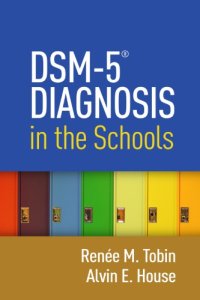
Ebook: DSM-5 diagnosis in the schools
Author: House Alvin E., Tobin Renée Margaret
- Tags: Adolescent psychopathology--Diagnosis, Child psychopathology--Diagnosis, EDUCATION--Educational Psychology, MEDICAL--Psychiatry--Child & Adolescent, PSYCHOLOGY--Psychotherapy--Child & Adolescent, SOCIAL SCIENCE--Social Work, Child psychopathology -- Diagnosis, Adolescent psychopathology -- Diagnosis, Diagnostic and statistical manual of mental disorders, PSYCHOLOGY -- Psychotherapy -- Child & Adolescent, MEDICAL -- Psychiatry -- Child & Adolescent, SOCIAL SCIENCE -- Social Work, EDUCATION -- Educational Psy
- Year: 2016
- Publisher: The Guilford Press
- City: New York
- Language: English
- pdf
1. Introduction: Purposes and Features of This Book -- Part I. Diagnostic Issues and the Use of DSM-5. 2. Psychiatric Diagnosis: Issues for School Psychologists ; 3. An Overview of the DSM-5 Diagnostic System ; 4. Learning to Use DSM-5 -- Part II. Guidelines for Evaluation of Presenting Problems. 5. Problems with Intellectual Ability and Cognition ; 6. Learning, Communication, and Motor Problems ; 7. Highly Atypical Symptom Patterns: Autism Spectrum Disorders and Psychoses ; 8. Mood Problems ; 9. Anxiety Problems ; 10. Other Internalizing Problems ; 11. Problems with Conduct ; 12. Problems with Impulse Control ; 13. Highly Focused Symptom Patterns ; 14. Substance-Related Problems and Other Addictive Behaviors ; 15. Personality Disorders ; 16. Additional Codes and Categories -- Part III. The Application of DSM-5 In School Settings: Issues and Topics. 17. Ethics and Professional Responsibility in Evaluation ; 8. The Case Record: Data and Supporting Documentation for Diagnosis ; 19. Seeking Reimbursement for Assessment and Diagnosis within School Settings ; 20. DSM-5 and the Individuals with Disabilities Education Improvement Act ; 21. Concerns about DSM-5.;Thousands of practitioners using prior versions of DSM have relied on this key resource to optimize their diagnostic practices in PreK-12 settings. Now significantly revised for DSM-5, the book cuts through the overwhelming length and complexity of the diagnostic manual by focusing thematically on the most common child and adolescent concerns. Tips are provided for diagnostic decision making and coding, and technical terms are demystified. Emphasis is given to using diagnosis as a foundation for effective intervention. The book highlights links to special education eligibility under IDEA and discusses ethical and professional issues in school-based assessment. New to This Edition *Revised throughout for DSM-5. *Restructured chapters on learning, communication, and motor problems; mood problems; anxiety problems; conduct problems; and impulse-control problems. *Updated content on IDEA 2004. *DSM-IV-TR Notes encapsulating changes to each set of diagnostic criteria. *Author Commentary sidebars sharing clinical insights and experiences";Efficient and accurate use of the American Psychiatric Association's (2013) Diagnostic and Statistical Manual of Mental Disorders, fifth edition (DSM-5) has become a necessary part of the professional duties of psychologists in a variety of clinical, rehabilitative, and child service agencies. This book is intended to increase child psychologists' familiarity with DSM-5 and to bolster their confidence in using it within school settings. The present text attempts to provide a broad understanding of the DSM-5 system--what it attempts to do, how it is organized, and how to use it most effectively to capture and communicate the unique features of children's and adolescent's problems"
Download the book DSM-5 diagnosis in the schools for free or read online
Continue reading on any device:

Last viewed books
Related books
{related-news}
Comments (0)